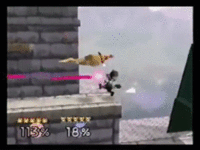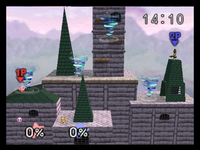Hyrule Castle
| Hyrule Castle | |
|---|---|
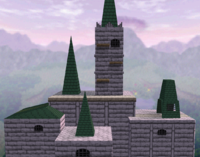 File:ZeldaSymbol.png | |
| Universe | The Legend of Zelda |
| Appears in | SSB SSB4 |
| Availability | Starter |
| Tracks available | Track 7 |
| Article on Zelda Wiki | Hyrule Castle |
Hyrule Castle (ハイラル城, Hyrule Castle) is a playable stage in Super Smash Bros. and home to Link. It did not return in Super Smash Bros. Melee, although another Hyrule-based stage, Temple, appeared.
On 14 June 2015, it was teased in a Nintendo Direct as a returning stage in Super Smash Bros. for Wii U.
Layout
The stage has a large main platform in the center. Three platforms float about midway across the main platform, with the middle to the right of the top and bottom ones. The bottom platform is just high enough for Captain Falcon's up smash to be able to hit opponents standing on it. The platforms can allow combos such as the Stairway to Heaven to be performed for longer, and situational vertical KOs can also occur on the top platform, KOing at unusually low percentages. Characters such as Mario can also make use of the platforms to land vertical finishers, such as an up smash in Mario's case. Connected to the left of the main platform is a slightly lower, slanted platform. To the right of the main platform is a lower, connected platform with a dark green gazebo-like structure in the middle of it. Characters may stand on top of it, but may not jump through it. This portion of the stage is known in competitive play as the tent (see below for more information).
In competitive play, Fox generally dominates on this stage due to its large size and high amount of space allowing him to use his blaster to projectile camp much easier than on Dream Land. Link is also much more effective on this stage for a similar reason. Both are also less vulnerable to gimps and offstage combos on this stage, particularly Link, who relies on his projectiles to space against opponents and avoid being hit offstage.
Tent
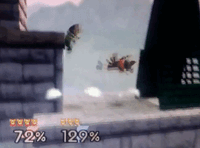
The area to the right of the main platform is commonly referred to as the "Tent" by the Smash 64 community, and also known as the "Combo Tent" to a lesser extent. Players refer to it as this because characters can use aerials and throws to knock opponents off walls and into combos or KO moves. This was made famous by Isai's "Greenhouse" combo (performed using Pikachu), which involves using multiple up tilts, a back throw against the left wall, back aerial against the structure, up smash on the main platform (where the opponent will get knocked after being hit by the back aerial), and then a Thunderspike.
Forward and back throws can be used to chaingrab the opponents against the walls to rack up more damage, and the up tilts may also be skipped if the opponent is already in the right position for a grab. Many other characters can perform their own variations of this combo. For example, Fox can use his back throw against the left wall to combo into a down aerial, which can subsequently lead into a regrab to continue the chain. He can also use the same throw to combo into an up aerial, which is a KO setup, especially against floaty characters.
Another advanced tent combo performed with Fox is the "shine pillar up smash" combo, popularized by The Z. It involves launching the opponent to the top of the structure with an up tilt, jumping up to the top of the structure, cancelling aerial momentum with a shine, then immediately using an up smash to KO the opponent while they are still in hitstun.
Moves such as Pikachu's up aerial and Captain Falcon's back aerial can also be used to repeatedly knock an opponent against the structure.
Features
The only terrain effect are the four tornadoes, commonly called "nados" or the "nado" in the Smash 64 community, which spawn randomly over the stage. They tend to last around 10-20 seconds, and move randomly in a direction, although they may suddenly speed up and home in on a character. If caught, a character is held for about 2 seconds before being dealt 14% and thrown upward, KOing between 65% and 130% depending on weight of character and location of the tornado. The tornado's knockback is similar to a throw in which it cannot be SDI'd. It is possible to attack someone while they are in a tornado as well, and it is possible to hit the opponent with an aerial when they are released, including a meteor smash to knock opponents back into a tornado to rack up more damage. Tornados, due to their large vertical knockback, can also be used by Pikachu players to set up Thunderspikes if the opponent is caught in one. If a tornado speeds up and/or catches a character, it tends to spend less time on stage. The image to the side show the locations of the four tornados/nados spawns.
In competitive play
According to the American ruleset, Hyrule Castle is considered to be a banned stage. Although it was considered to be the second most neutral stage, behind Dream Land, for a long time, the disadvantages of the hazards and features of the stage have become more apparent in the more recent metagame. The tornado hazards on the stage are known for appearing completely randomly, without any indication of the position where the tornado appeared if the tornado is outside of the screen's reach. The tornadoes also speed up at random times, which can catch even more wary players offguard, and fully cover options that would have otherwise been completely safe. The stage's large size also allows significant camping in certain positions, as in certain matchups, it is possible for one player to camp on the far left of the stage and make it extremely difficult for the opponent to approach safely (a primary example is Kirby against Captain Falcon, as Kirby can stay on the far left of the stage and space up tilts and back airs to cover all of Captain Falcon's safe approach options, with a match between Mew2King and Stranded involving this technique being infamous). It is also possible for several characters to camp the top platform, such as Pikachu and Kirby. This was made famous by SuperBoomFan who had a 53 minute game with Gerson.
Bane is often credited for being a significant contributor to the banning of Hyrule Castle, detailing the disadvantages of the stage in a SmashBoards thread named A Case Against Hyrule, and also comparing the stage's legality to other stages. However, Hyrule Castle remains a popular stage among many players due to the unique combos possible in the tent portion and the strategies that are usable due to the stage's structure. Due to the Gentleman Rule in most rulesets that allows any banned stage to be played on if both players agree, Hyrule Castle is still seen in tournaments even if the ruleset renders it banned.
Hyrule Castle has always been banned in the Japanese ruleset, as Dream Land is considered the only neutral and legal stage in said ruleset. The Peruvian ruleset contrasts with this, as Hyrule Castle is considered to be the only neutral and legal stage in said ruleset. However, as per late 2014, Hyrule is also being phased out for Dream Land, due to the same reasoning.
Origin
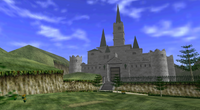
Ever since The Legend of Zelda: A Link to the Past there has been a Hyrule Castle where Princess Zelda and other members of the royal family live. The Hyrule Castle seen in this stage is based around Ocarina of Time. This stage is an accurate rendition of the castle seen in Ocarina of Time except there are no platforms that go up the middle tower and the spear on the right has been turned into a gazebo-like structure.
In The Legend of Zelda, a recorder can be played to summon a tornado that warps the player to a certain dungeon depending on the direction the person is facing. This is the only Zelda game before Ocarina of Time to feature a tornado. In this stage there is a tornado that throws players upward. The tornado itself could be a reference to The Legend of Zelda, but what the tornado does has no relation to it. Death Mountain, a volcano in Ocarina of Time, can be seen in the background.
The music for this stage is a remixed version of The Legend of Zelda's overworld, specifically, the incarnation from A Link to the Past.
Description from the Instruction Booklet
A tornado spins about the stage, wreaking havoc on all that cross its path.
Gallery
Hyrule Castle as it appears in Super Smash Bros. for Wii U.
Trivia
- Maxim Tomatoes never appear on this stage. If the Maxim Tomato is the only item turned on via Item Switch, all the crates and capsules that appear will be explosive or empty.
- This is the only stage from The Legend of Zelda universe to have ever been considered tournament legal in both singles and doubles.
External links
| Stages in Super Smash Bros. | |
|---|---|
| Starter stages | Congo Jungle · Dream Land · Hyrule Castle · Peach's Castle · Planet Zebes · Saffron City · Sector Z · Yoshi's Island |
| Unlockable stage | Mushroom Kingdom |

